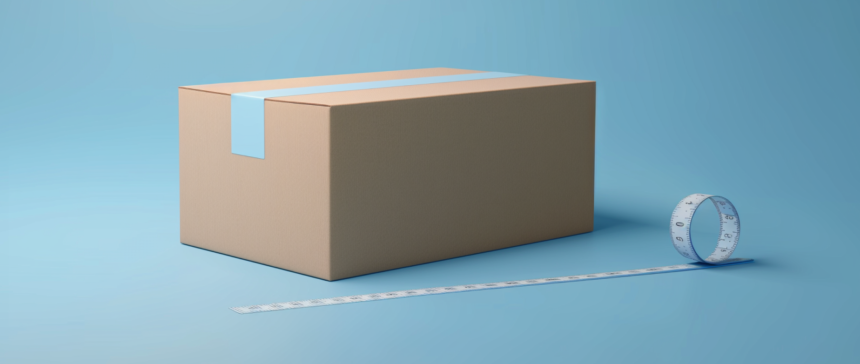Don’t worry, “how to measure a box” isn’t a silly question. Preparing a package to ship can be confusing the first time you do it, especially if you’re running a new business. Fulfilling the first order.
Knowing how to accurately measure a box is essential for shipping. Carriers and freight companies may ask for the dimensions, volume, or girth because they charge based on the dimensional weight (volume) or actual weight of the package. Knowing these numbers can help you: Secure better shipping rates Or, determine what shipping method works best for your business.
Once you understand how to measure your shipping boxes and ensure the best rates, the process becomes a simple part of doing business, so it’s important to get it right the first time.
How to measure a box
To measure your luggage, you will need measuring tools such as a tape measure or ruler, as well as a pencil and paper to write down the dimensions.
To determine the size of your shipping box, you will need to measure the outside dimensions.
When measuring a shipping box, measure the length, width, and height (L x W x H). Dimensions should always be listed in this industry standard order.
To measure the dimensions of a box:
- First, measure the length. This will be the longest side of the box with the flaps.
- Next, measure the width. There is a flap on the wide side, but it is shorter than the long side. Rotate the box 90 degrees and measure the width.
- Finally, measure the height: close the lid of the box and use a tape measure to calculate the height from top to bottom.

Notes: Allowable manufacturing variation is +/- ⅛ inches.
How to Calculate Box Volume
Knowing the volume of your shipment makes it easier to handle shipping, warehousing, and distribution. Calculating volume is essential for optimizing materials and costs.
To calculate the volume of the package you are shipping, you need to multiply the length x width x height.
L x W x H = Volume. Example:
- L = 16 inches
- Width = 12 inches
- Height = 8 inches
16 x 12 x 8 = 1,536 cubic inches (cu).

How to measure the circumference of a box
You may need to calculate girth for unusually shaped packages, such as the cylindrical containers used to ship prints and posters.
First, you’ll need to measure the width and height of your package. Use a flexible tape measure to measure the distance around the widest part of your package. This measurement is the width. Then, measure around the longest part from top to bottom. This is the height.
To calculate girth, use the formula: width times height x 2.
Chest = 2 x (Width + Height)
If we use the example box from above, add the width (12 inches) and the height (8 inches). This equals 20. Then multiply it by 2 to get the girth: 40 inches.
40 inches = 2 x (12 + 8)
How to keep shipping costs low
Shipping costs are rising all over the world, so be careful. Changes to shipping feesThese Shipping tips for small businesses You can minimize costs:
- Use an appropriate container. Using large shipping boxes for small or light products can be costly. Always choose the smallest box necessary to safely ship your product. For smaller items, consider lightweight poly mailers instead of boxes.
- Reuse old boxes and “Ship in Own Container” (SIOC) packaging. In some cases, simply sticking a shipping label on the product packaging can avoid the hassle of packaging it in a separate box.
- Take advantage of the discounts. Check if your e-commerce platform offers discounts on shipping fees. For example, Shopify Shipping Discounts from USPS, UPS and DHL allow vendors to save up to 88%.
- Please measure carefully. Most carriers will charge an additional fee for packages that exceed the originally listed weight.
Legal and career requirements
Different carriers have different requirements. For example, for domestic parcels: USPS requires the combined length and girth to be less than 108 inches However, if you are sending via USPS Ground Advantage, the combined length and girth of the package is limited to 130 inches. Packages must be at least 3 inches tall6 inches long and 1/4 inch thick.
Learn more about USPS ground shipping package requirements here hereFedEx has similar policies that you can review. here.
Common measurement mistakes
Mistakes can happen, especially when measuring multiple shipping boxes at the same time. Here are some of the most common mistakes:
- Measure from the inside. Your dimensions may be inaccurate because you are measuring from the smallest point of the box instead of the largest point. To avoid this, always measure from the outside of the box.
- Measurements on uneven surfaces. An uneven surface can lead to inaccurate measurements, make sure to measure the box on a flat and stable surface to avoid distortion.
- Measure the smallest point. Not all boxes are square or rectangular, for uneven, irregularly shaped boxes, measure from the widest and tallest points.
Measuring Shipping Box Dimensions FAQ
How do I calculate the box size?
To calculate the size of a box, measure its length, width, and height. Multiply the three measurements together to get its volume in cubic inches. For example, if a box is 10 inches long, 5 inches wide, and 4 inches high, its volume is 10 x 5 x 4, or 200 cubic inches.
Is there an app to measure boxes?
Yes, there are several apps that can measure a box. For example, the iPhone and iPad app Measure Kit provides an advanced suite of tools for measuring 3D objects. Other apps, like AR Measure, use augmented reality and your device’s camera to measure objects in real time.
Can I weigh my luggage without a scale?
You can weigh your package without a scale, but if you make a mistake, the measurement will be inaccurate and you may have to pay extra. We strongly recommend using a scale. A household scale will do, and most post offices have scales you can use.
How do I calculate package dimensions?
Length, width, height and girth are all dimensions. Measure the length, width and height of the item with a tape measure to get these measurements. To measure girth, add the width and height together and then double them.







